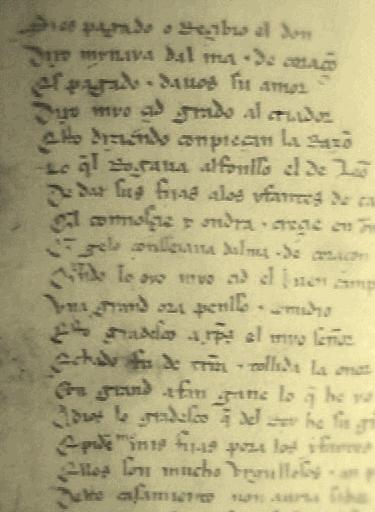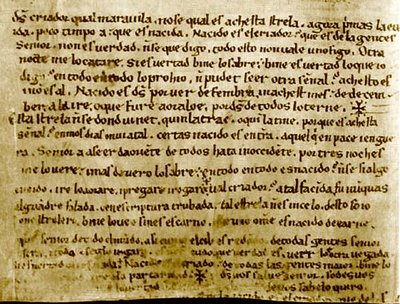|
Vulgar Latinity
Vulgar Latin, also known as Popular or Colloquial Latin, is the range of non-formal registers of Latin spoken from the Late Roman Republic onward. Through time, Vulgar Latin would evolve into numerous Romance languages. Its literary counterpart was a form of either Classical Latin or Late Latin, depending on the time period. Origin of the term During the Classical period, Roman authors referred to the informal, everyday variety of their own language as ''sermo plebeius'' or ''sermo vulgaris'', meaning "common speech". The modern usage of the term Vulgar Latin dates to the Renaissance, when Italian thinkers began to theorize that their own language originated in a sort of "corrupted" Latin that they assumed formed an entity distinct from the literary Classical variety, though opinions differed greatly on the nature of this "vulgar" dialect. The early 19th-century French linguist Raynouard is often regarded as the father of modern Romance philology. Observing that the Rom ... [...More Info...] [...Related Items...] OR: [Wikipedia] [Google] [Baidu] |
Roman Empire
The Roman Empire ( la, Imperium Romanum ; grc-gre, Βασιλεία τῶν Ῥωμαίων, Basileía tôn Rhōmaíōn) was the post-Republican period of ancient Rome. As a polity, it included large territorial holdings around the Mediterranean Sea in Europe, North Africa, and Western Asia, and was ruled by emperors. From the accession of Caesar Augustus as the first Roman emperor to the military anarchy of the 3rd century, it was a Principate with Italia as the metropole of its provinces and the city of Rome as its sole capital. The Empire was later ruled by multiple emperors who shared control over the Western Roman Empire and the Eastern Roman Empire. The city of Rome remained the nominal capital of both parts until AD 476 when the imperial insignia were sent to Constantinople following the capture of the Western capital of Ravenna by the Germanic barbarians. The adoption of Christianity as the state church of the Roman Empire in AD 380 and the fall of the Western ... [...More Info...] [...Related Items...] OR: [Wikipedia] [Google] [Baidu] |
Romance Philology
Romance studies or Romance philology ( an, filolochía romanica; ca, filologia romànica; french: romanistique; eo, latinida filologio; it, filologia romanza; pt, filologia românica; ro, romanistică; es, filología románica) is an academic discipline that covers the study of the languages, literatures, and cultures of areas that speak a Romance language. Romance studies departments usually include the study of Spanish, French, Italian, and Portuguese. Additional areas of study include Romanian and Catalan, on one hand, and culture, history, and politics on the other hand. Because most places in Latin America speak a Romance language, Latin America is also studied in Romance studies departments. As a result, non-Romance languages in use in Latin America, such as Quechua and Guarani, are sometimes also taught in Romance studies departments. Romance studies departments differ from single- or two-language departments in that they attempt to break down the barriers in s ... [...More Info...] [...Related Items...] OR: [Wikipedia] [Google] [Baidu] |
Cultural Assimilation
Cultural assimilation is the process in which a minority group or culture comes to resemble a society's majority group or assume the values, behaviors, and beliefs of another group whether fully or partially. The different types of cultural assimilation include full assimilation and forced assimilation; full assimilation being the most prevalent of the two, as it occurs spontaneously. During cultural assimilation, minority groups are expected to adapt to the everyday practices of the dominant culture through language and appearance as well as via more significant socioeconomic factors such as absorption into the local cultural and employment community. Some types of cultural assimilation resemble acculturation in which a minority group or culture completely assimilates into the dominant culture in which defining characteristics of the minority culture are less obverse or outright disappear; while in other types of cultural assimilation such as cultural integration mostly found i ... [...More Info...] [...Related Items...] OR: [Wikipedia] [Google] [Baidu] |
Language Assimilation
Language shift, also known as language transfer or language replacement or language assimilation, is the process whereby a speech community shifts to a different language, usually over an extended period of time. Often, languages that are perceived to be higher status stabilise or spread at the expense of other languages that are perceived by their own speakers to be lower-status. An example is the shift from Gaulish to Latin during the time of the Roman Empire. Mechanisms Prehistory For prehistory, Forster et al. (2004) and Forster and Renfrew (2011) observe that there is a correlation of language shift with intrusive male Y chromosomes but not necessarily with intrusive female mtDNA. They conclude that technological innovation (the transition from hunting-gathering to farming, or from stone to metal tools) or military prowess (as in the abduction of British women by Vikings to Iceland) causes immigration of at least some men, who are perceived to be of higher status than loca ... [...More Info...] [...Related Items...] OR: [Wikipedia] [Google] [Baidu] |
Roman Colonies
Colonies in antiquity were post-Iron Age city-states founded from a mother-city (its "metropolis"), not from a territory-at-large. Bonds between a colony and its metropolis remained often close, and took specific forms during the period of classical antiquity. Generally, colonies founded by the ancient Phoenicians, Carthage, Rome, Alexander the Great and his successors remained tied to their metropolis, but Greek colonies of the Archaic and Classical eras were sovereign and self-governing from their inception. While Greek colonies were often founded to solve social unrest in the mother-city, by expelling a part of the population, Hellenistic, Roman, Carthaginian, and Han Chinese colonies were used for trade, expansion and empire-building. Egyptian colony Egyptian settlement and colonisation is attested from about 3200 BC onward all over the area of southern Canaan with almost every type of artifact: architecture (fortifications, embankments and buildings), pottery, vessels, to ... [...More Info...] [...Related Items...] OR: [Wikipedia] [Google] [Baidu] |
Mediterranean Basin
In biogeography, the Mediterranean Basin (; also known as the Mediterranean Region or sometimes Mediterranea) is the region of lands around the Mediterranean Sea that have mostly a Mediterranean climate, with mild to cool, rainy winters and warm to hot, dry summers, which supports characteristic Mediterranean forests, woodlands, and scrub vegetation. Geography The Mediterranean Basin covers portions of three continents: Europe, Africa, and Asia. It is distinct from the drainage basin, which extends much further south and north due to major rivers ending in the Mediterranean Sea, such as the Nile and Rhône. Conversely, the Mediterranean Basin includes regions not in the drainage basin. It has a varied and contrasting topography. The Mediterranean Region offers an ever-changing landscape of high mountains, rocky shores, impenetrable scrub, semi-arid steppes, coastal wetlands, sandy beaches and a myriad islands of various shapes and sizes dotted amidst the clear blue sea. C ... [...More Info...] [...Related Items...] OR: [Wikipedia] [Google] [Baidu] |
Welsh Language
Welsh ( or ) is a Celtic language family, Celtic language of the Brittonic languages, Brittonic subgroup that is native to the Welsh people. Welsh is spoken natively in Wales, by some in England, and in Y Wladfa (the Welsh colony in Chubut Province, Argentina). Historically, it has also been known in English as "British", "Cambrian", "Cambric" and "Cymric". The Welsh Language (Wales) Measure 2011 gave the Welsh language official status in Wales. Both the Welsh and English languages are ''de jure'' official languages of the Welsh Parliament, the Senedd. According to the 2021 United Kingdom census, 2021 census, the Welsh-speaking population of Wales aged three or older was 17.8% (538,300 people) and nearly three quarters of the population in Wales said they had no Welsh language skills. Other estimates suggest that 29.7% (899,500) of people aged three or older in Wales could speak Welsh in June 2022. Almost half of all Welsh speakers consider themselves fluent Welsh speakers ... [...More Info...] [...Related Items...] OR: [Wikipedia] [Google] [Baidu] |
Albanian Language
Albanian ( endonym: or ) is an Indo-European language and an independent branch of that family of languages. It is spoken by the Albanians in the Balkans and by the Albanian diaspora, which is generally concentrated in the Americas, Europe and Oceania. With about 7.5 million speakers, it comprises an independent branch within the Indo-European languages and is not closely related to any other modern Indo-European language. Albanian was first attested in the 15th century and it is a descendant of one of the Paleo-Balkan languages of antiquity. For historical and geographical reasons,: "It is often thought (for obvious geographic reasons) that Albanian descends from ancient Illyrian (see above), but this cannot be ascertained as we know next to nothing about Illyrian itself." the prevailing opinion among modern historians and linguists is that the Albanian language is a descendant of a southern Illyrian dialect spoken in much the same region in classical times. Alternativ ... [...More Info...] [...Related Items...] OR: [Wikipedia] [Google] [Baidu] |
Loanword
A loanword (also loan word or loan-word) is a word at least partly assimilated from one language (the donor language) into another language. This is in contrast to cognates, which are words in two or more languages that are similar because they share an etymological origin, and calques, which involve translation. Loanwords from languages with different scripts are usually transliterated (between scripts), but they are not translated. Additionally, loanwords may be adapted to phonology, phonotactics, orthography, and morphology of the target language. When a loanword is fully adapted to the rules of the target language, it is distinguished from native words of the target language only by its origin. However, often the adaptation is incomplete, so loanwords may conserve specific features distinguishing them from native words of the target language: loaned phonemes and sound combinations, partial or total conserving of the original spelling, foreign plural or case forms or indecli ... [...More Info...] [...Related Items...] OR: [Wikipedia] [Google] [Baidu] |
Grammarian (Greco-Roman World)
Grammarian may refer to: * Alexandrine grammarians, philologists and textual scholars in Hellenistic Alexandria in the 3rd and 2nd centuries BCE * Biblical grammarians, scholars who study the Bible and the Hebrew language * Grammarian (Greco-Roman), a teacher in the second stage in the traditional education system * Linguist, a scientist who studies language * Philologist, a scholar of literary criticism, history, and language * Sanskrit grammarian, scholars who studied the grammar of Sanskrit * Speculative grammarians or Modistae, a 13th and 14th century school of philosophy * Grammarians of Basra, scholars of Arabic * Grammarians of Kufa, scholars of Arabic See also * Grammar, the structural rules that govern natural languages * ''Grammaticus'', a name used by several scholars * Neogrammarian The Neogrammarians (German: ''Junggrammatiker'', 'young grammarians') were a German school of linguists, originally at the University of Leipzig, in the late 19th century who proposed the ... [...More Info...] [...Related Items...] OR: [Wikipedia] [Google] [Baidu] |
Epigraphy
Epigraphy () is the study of inscriptions, or epigraphs, as writing; it is the science of identifying graphemes, clarifying their meanings, classifying their uses according to dates and cultural contexts, and drawing conclusions about the writing and the writers. Specifically excluded from epigraphy are the historical significance of an epigraph as a document and the artistic value of a literature, literary composition. A person using the methods of epigraphy is called an ''epigrapher'' or ''epigraphist''. For example, the Behistun inscription is an official document of the Achaemenid Empire engraved on native rock at a location in Iran. Epigraphists are responsible for reconstructing, translating, and dating the trilingual inscription and finding any relevant circumstances. It is the work of historians, however, to determine and interpret the events recorded by the inscription as document. Often, epigraphy and history are competences practised by the same person. Epigraphy ... [...More Info...] [...Related Items...] OR: [Wikipedia] [Google] [Baidu] |



.png)


